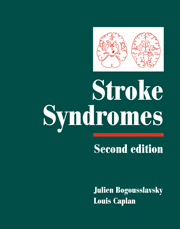Book contents
- Frontmatter
- Contents
- List of contributors
- Preface
- PART I CLINICAL MANIFESTATIONS
- 1 Stroke onset and courses
- 2 Clinical types of transient ischemic attacks
- 3 Hemiparesis and other types of motor weakness
- 4 Sensory abnormality
- 5 Cerebellar ataxia
- 6 Headache: stroke symptoms and signs
- 7 Eye movement abnormalities
- 8 Cerebral visual dysfunction
- 9 Visual symptoms (eye)
- 10 Vestibular syndromes and vertigo
- 11 Auditory disorders in stroke
- 12 Abnormal movements
- 13 Seizures and stroke
- 14 Disturbances of consciousness and sleep–wake functions
- 15 Aphasia and stroke
- 16 Agitation and delirium
- 17 Frontal lobe stroke syndromes
- 18 Memory loss
- 19 Neurobehavioural aspects of deep hemisphere stroke
- 20 Right hemisphere syndromes
- 21 Poststroke dementia
- 22 Disorders of mood behaviour
- 23 Agnosias, apraxias and callosal disconnection syndromes
- 24 Muscle, peripheral nerve and autonomic changes
- 25 Dysarthria
- 26 Dysphagia and aspiration syndromes
- 27 Respiratory dysfunction
- 28 Clinical aspects and correlates of stroke recovery
- PART II VASCULAR TOPOGRAPHIC SYNDROMES
- Index
- Plate section
13 - Seizures and stroke
from PART I - CLINICAL MANIFESTATIONS
Published online by Cambridge University Press: 17 May 2010
- Frontmatter
- Contents
- List of contributors
- Preface
- PART I CLINICAL MANIFESTATIONS
- 1 Stroke onset and courses
- 2 Clinical types of transient ischemic attacks
- 3 Hemiparesis and other types of motor weakness
- 4 Sensory abnormality
- 5 Cerebellar ataxia
- 6 Headache: stroke symptoms and signs
- 7 Eye movement abnormalities
- 8 Cerebral visual dysfunction
- 9 Visual symptoms (eye)
- 10 Vestibular syndromes and vertigo
- 11 Auditory disorders in stroke
- 12 Abnormal movements
- 13 Seizures and stroke
- 14 Disturbances of consciousness and sleep–wake functions
- 15 Aphasia and stroke
- 16 Agitation and delirium
- 17 Frontal lobe stroke syndromes
- 18 Memory loss
- 19 Neurobehavioural aspects of deep hemisphere stroke
- 20 Right hemisphere syndromes
- 21 Poststroke dementia
- 22 Disorders of mood behaviour
- 23 Agnosias, apraxias and callosal disconnection syndromes
- 24 Muscle, peripheral nerve and autonomic changes
- 25 Dysarthria
- 26 Dysphagia and aspiration syndromes
- 27 Respiratory dysfunction
- 28 Clinical aspects and correlates of stroke recovery
- PART II VASCULAR TOPOGRAPHIC SYNDROMES
- Index
- Plate section
Summary
Introduction
Historical references for stroke as a cause of seizures date back to Greco-Roman times when Hippocrates in 400 BC described epilepsy as a disease of the brain due to natural rather than supernatural causes. Hippocrates described older persons with paralysis following seizures consistent with seizures occurring at the onset of stroke. However, it was not until 1864 that Hughling Jackson clearly documented stroke as a cause of epilepsy. Jackson noted that ‘it is notuncommonto find when a patient has recovered or is recovering from hemiplegia, the result of embolism of the middle cerebral artery, or ofsomebranch of this vessel, that he is attacked by convulsions beginning in some part of the paralysed region’. (Taylor, 1958). Since these times it has become clear that stroke is an important cause of seizures and epilepsy, particularly in the older age group. There are, however, some important questions still to be answered.
Post stroke seizures – comparison of cerebral infarction with hemorrhage
Timing and frequency of seizures
Reports on the frequency of seizures at the onset of, and following, stroke vary quite widely because of differing stroke patient populations, sample sizes studied, follow up periods, definitions used for stroke and seizures, use of investigations such as computerized tomography (CT) and types of statistical analysis. In most studies to date the follow-up period was less than a few weeks, so the documentation of later onset or recurring seizures is limited. Studies of early and late onset poststroke seizures where patients with prestroke seizures, were largely excluded and CT was used in the diagnosis of cerebral ischemia or hemorrhage in 90% or more of patients, are summarized in Table 13.1.
- Type
- Chapter
- Information
- Stroke Syndromes , pp. 182 - 191Publisher: Cambridge University PressPrint publication year: 2001
- 3
- Cited by

